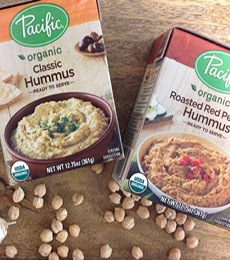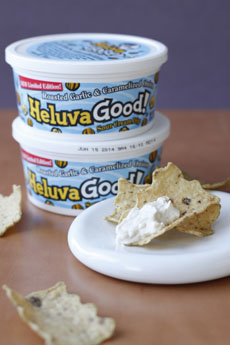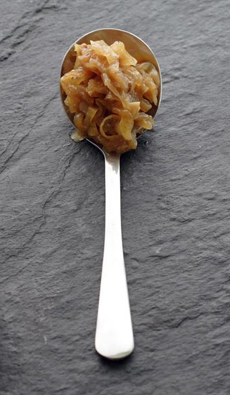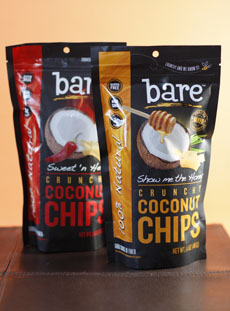
[1] Pork belly lettuce wraps: a real treat (photo © Sushi Samba).
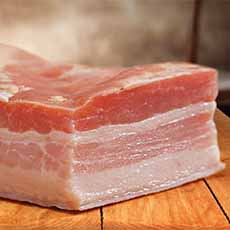
[2] A slab of uncooked pork belly (phoco © The Country Victualler).

[3] Hearts of palm, a.k.a. palmito (photo © Trikaya).
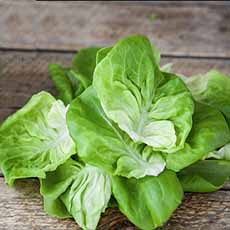
[4] Butterhead lettuce, a category that includes Bibb and Boston. Here are the different types of Butterhead lettuce (photo © Good Eggs).
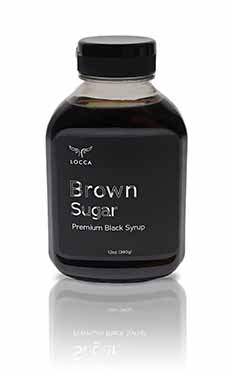
[5] You can purchase kuromitsu at Asian markets or online (photo © Locca | Amazon).
|
|
In honor of the World Cup Games in Brazil, Brazilian-Japanese fusion restaurant Sushisamba will be serving a signature dish from Chef Pedro Duarte: Kuromitsu Pork Belly Lettuce Wraps.
Kuromitsu is a Japanese sugar syrup, similar to but milder than molasses. We could eat an entire tray of these sweetly glazed pork belly treats. Consider them as a first course for Father’s Day dinner…or make all four and keep them for yourself.
> November 10th is National Pork Belly Day.
> The different cuts of pork.
RECIPE #1: KUROMITSU GLAZED PORK BELLY LETTUCE WRAPS
Ingredients For The Pork Belly Confit (Yields 4 Five-Ounce Portions)
1.25 pounds pork belly
1 ounce salt
1 ounce sugar
1 liter canola oil
1 bouquet garni (thyme, garlic, bay leaf, black pepper)
Preparation
1. RUB the pork belly with the sugar/salt mixture and allow to marinate for 6 hours.
2. RINSE, pat dry, and submerge in a hotel pan (also called a steam table pan—a deep roasting pan will do) with the canola oil and bouquet garnish. Cover with tin foil and cook in the oven for 4 hours at 325°F.
3. REMOVE from the oil when the pork belly is soft and allow it to cool in the refrigerator with some weight on top. You can reuse the oil for another cooking process.
RECIPE #2: LETTUCE WRAPS
Ingredients Per Serving
4.5 ounces pork belly confit (recipe above)
1 ounce kuromitsu glaze (see below)
Lemon zest, to taste
1 ounce hearts of palm (palmito), julienned
1 ounce frisée
1 bibb lettuce leaf
Preparation
1. PREPARE the pork belly a day in advance in advance (6 hours marinating plus 4 hours cooking). To assemble:
2. MIX lemon zest, palmito, and frisée to create garnish. To plate, place 1 piece of pork belly on 1 piece of bibb lettuce. Brush pork belly with kuromitsu glaze. Top with the fresh palmito-frisée salad. It’s delicious!
WHAT IS KUROMITSU?
Kuromitsu is a Japanese sugar syrup, typically made from unrefined Okinawan kurozato (black sugar). The term means “black honey”; it is similar to molasses but thinner and milder.
It is also called brown sugar syrup.
It is used to add sweetness to sweet Japanese dishes. It is one of the ingredients used in making wagashi, and it serves well with kuzumochi, fruits, ice cream, and cakes. Drizzle it on your choice of Japanese sweets, such as anmitsu, shiratama dango, kudzu mochi, warabi mochi, or kinako on toast. Or on western-style pancakes.
The syrup is also used in bubble tea recipes.
You can find premade kuromitsu in Asian products stores, but here’s a recipe courtesy of Taste Of Zen.
RECIPE #3: HOMEMADE KUROMITSU
Ingredients For 1 Cup
2/3 cup dark muscovado or other unrefined brown cane sugar (the different types of brown sugar)
2 tablespoons light muscovado sugar
1/2 cup white table sugar
1/2 cup hot or boiling* water
_______________
*It’s better to stir boiled water, not cool water, as it won’t spatter and burn you.
|
